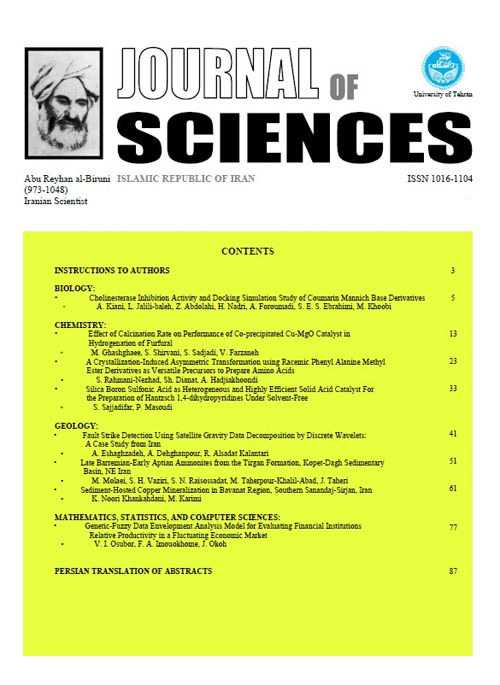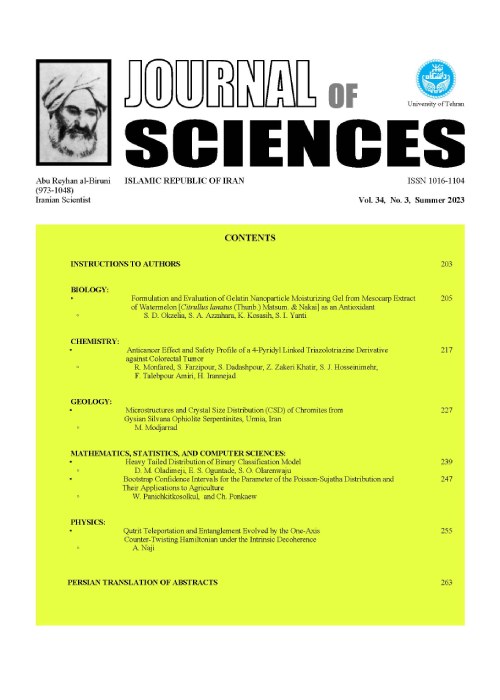فهرست مطالب

Journal of Sciences, Islamic Republic of Iran
Volume:30 Issue: 1, Winter 2019
- تاریخ انتشار: 1397/11/09
- تعداد عناوین: 8
-
-
Cholinesterase Inhibition Activity and Docking Simulation Study of Coumarin Mannich Base DerivativesPages 5-12Inhibition of acetylcholinesterase and butyrylcholinesterase (AChE and BuChE) as two major forms of cholinesterases (ChEs) is considered as the common approach for the treatment of Alzheimer's disease (AD). The present study was done to explore the anticholinesterase inhibition property of coumarin Mannich base derivatives. A series of cumarin Manich bases were synthesized (4a-h) through one-pot tri-component reaction in an environmentally friendly condition and evaluated against AChE and BuChE by Ellman's assay. Ligand-protein docking simulation was also performed for the most active compound 4a. Additionally, the criteria of drug likeness of the target compounds was predicted using SwissADME web service. All compounds exhibited weak to moderate inhibitory activity against both AChE and BuChE enzymes. Compound 4a containing p-tolyl piperazin group showed the best activity against AChE (42.4 % at 32 µM), while compound 4g bearing phenylpiperazine moiety was the best BuChE inhibitor (43.9% at 32 µM). Ligand-protein docking simulation also exhibited that the main part of compound 4a in ChE inhibitory activity is amine moiety. Moreover, the prediction of "Lipinski's rule of five" showed that most target compounds can cross the BBB and have properties that would make them likely orally active compounds in humans. This study suggested that the synthesized cumarin Manich bases with some more structural modifications may be considered as a potential compound to target AChE and BuChE.Keywords: Alzheimer’s disease, Acetylcholinesterase, Butyrylcholinesterse, 4-Hydroxycoumarin, Mannich base
-
Pages 13-21Co-precipitated Cu-MgO catalysts were prepared and evaluated for the gas-phase hydrogenation of furfural. The effect of heating rate at the calcination step was studied by comparing the performance of three catalysts prepared via the same procedure but calcined at different heating rates. The results established that altering the heating rate could influence the structural properties of the catalyst samples and hence their activity and selectivity. An extremely poor catalytic activity and selectivity (lower than 0.1% conversion of furfural and 40% selectivity towards furfuryl alcohol after 240 min time-on-stream) belonged to the catalyst that was prepared with the lowest calcination rate (1 Kmin–1), while the other two catalysts prepared with the calcination rate of 5 and 10 Kmin–1 indicated more than 88% conversion of furfural and 85% furfuryl alcohol selectivity during this run length.Keywords: Hydrogenation, Furfural, Furfuryl alcohol, Copper, Calcination
-
Pages 23-31L-Tyrosine and L-Dopa are the precursors in the biological synthesis of amine neurotransmitters. On the other hand, phenylalanine as an aromatic amino acid (AAA) is a precursor in the synthesis of L-Tyrosine and L-Dopa. For some substrates such as amino acids, resolution by the formation of diastereomers offers an attractive alternative. Among different methods in this case, crystallization-induced asymmetric transformation (CIAT) that is in situ racemization and selective crystallization of a reaction product can be a good choice. Using this method, preparation of L-Tyrosine and L-Dopa has been reported. In the synthetic route, racemic phenyl alanine methyl ester derivatives as versatile precursors were prepared by reducing azlactone derivatives with Mg in methanol as a reducing reagent and then in the resolution step (S)- enantiomer of L-Dopa (3,4-dihydroxyphenylalanine) and L-Tyrosine (4-hydroxyphenylalanine) were achieved via salt formation with (2R,3R)-tartaric acid in the presence of 5-nitro salicylaldehyde in good yield and high optical purity.Keywords: Azlactone, Racemic-phenylalanine methyl ester, Amino acids, Asymmetric transformation
-
Pages 33-40Silica boron sulfonic acid [SiO2–B(OSO3H)3] as an inexpensive, reusable, and Lewis and Brønsted acid catalyst was successfully synthesized, and used for the one-pot three-components synthesis of biologically active substituted Hantzsch 1,4-dihydropyridine derivatives in the absence of solvent at 90ºC. Silica boron sulfonic acid is attractive and efficient, because it plays in two role as a Lewis acid (by boron atom) and also as a Brønsted acid (by OSO3H group), which can have a better effect in reaction. The reaction was carried out under solvent-free and mild conditions. Silica boron sulfonic acid can be recovered and reused for at least five consecutive runs.Keywords: Lewis, Br?nsted acidic, Hantzsch Reaction, 1, 4-dihydropyridine, Solvent-free, One-pot condensation
-
Pages 41-50Estimating the gravity anomaly causative bodies boundary can facilitate the gravity field interpretation. In this paper, 2D discrete wavelet transform (DWT) is employed as a method to delineate the boundary of the gravity anomaly sources. Hence, the GRACE’ satellite gravity data is decomposed using DWT. DWT decomposites a single approximation coefficients into four distinct components: the approximation, horizontal, vertical and diagonal. For evaluating the efficiency of wavelets, both the noisy and free-noise synthetic gravity data, have been decomposed at level 1 with six discrete two-dimensional wavelets. In this manuscript, the satellite gravity data of a part of the Makran region (in the south-east of Iran) is decomposed by DWT in order to detect the Saravan Fault trend. The outcome indicates the acceptable performance of the Haar and Biorthogonal mother wavelets in detecting the edges of the real and synthetic gravity anomaly sources. Also, the results demonstrate that the satellite gravity data can be appropriate to study the regional geological structures, particular in revealing the hidden faults where have great importance in earthquake risk analysis.Keywords: Discrete wavelet transform (DWT), Makran, Saravan fault, Satellite gravity
-
Pages 51-59During the recent field research on the Tirgan Formation in the west of Kopet-Dagh sedimentary basin, ammonite assemblages were obtained from the carbonate strata of this formation. This new finding is important for stratigraphical purpose. In this research, 3 genera belong to Heteroceras, Deshayesites and Cheloniceras? as well as one uncertain genus belongs to Turkmeniceras are determined. The ammonite fauna dates the Tirgan Formation from the late Barremian to early Aptian in the studied stratigraphic section.Keywords: Ammonite, Lower Cretaceous, Late Barremian, Early Aptian, Tirgan Formation
-
Pages 61-75Sedimentary Copper mineralization has been observed in Monj and Jolany locations in Bavanat (Sanandaj – Sirjan metamorphic belt). According to current study, the host rocks for copper mineralization in this area are green sandstones, generally in subarkose and arkose groups. Age of these sandstones is middle Jurassic. Copper mineralization is observed in two forms, sulfides form including chalcopyrite, chalcocite, covellite and also non-sulfide form including malachite, azurite and chrysocolla. Sedimentary Copper deposit of Bavanat is very similar to redbed type of sedimentary deposits such as Nacimiento deposit in USA for many reasons, including the host rock (green sandstone), concomitant rocks (habitual accompaniment with purple siltstone), age of forming, geological environment and the type of mineralization. These similarities can be useful in supplementary studies. Studied sedimentary copper deposits are different from the Jian copper mine in terms of attributes such as host rock, age of formation, upper and lower rocks and also the type of copper mineralization. Based on chemical analysis results, the average amount of copper concentration in the samples was 15509 ppm, which confirms the need for additional studies.Keywords: Bavanat, Sedimentary Copper Mineralization, Redbed
-
Pages 77-86This paper presents a Genetic Algorithm Fuzzy Data Envelopment Analysis (GA-FDEA) model that caters for optimal selecting of economic indicators for the measurement of relative productivity and performance of financial institutions. Imprecise or uncertain data of financial institutions due to varying monetary policies and market risk were retrieved from Nigeria Stock Exchange Commission and evaluated. It was observed that GA-FDEA provides better results than the conventional DEA. The findings provide economic barometers for ascertaining the viability of these institutions toward bringing the expected growth of these institutions and the nation at large.Keywords: Fuzzy, Data Envelopment Analysis, Finance, Genetic Algorithm


